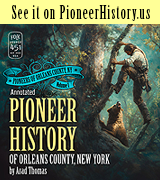DEC says past 5 years safest on record for hunters
Press Release, Department of Environmental Conservation
The 2017 hunting seasons in New York saw the second-lowest number of hunting-related shooting incidents on record, 19, Department of Environmental Conservation Commissioner Basil Seggos announced today.
Also in 2017, at Commissioner Seggos’ direction, the DEC started tracking tree stand injuries for the first time. DEC recorded 12 incidents statewide.
“The tradition of hunting is enjoyed by more than 500,000 New Yorkers each year, and the declining number of incidents show that today’s generation of hunters may be the most safety conscious,” Seggos said. “Thanks to the efforts of 2,600 DEC staff and volunteer hunter education program instructors that teach nearly 50,000 students each year, New York’s hunting safety statistics continue to improve.”
Of the 19 hunting-related shooting incidents that occurred last year, 14 were two-party firearm incidents, five were self-inflicted, and one resulted in a fatality that DEC believes could have been prevented if hunting laws and common sense were followed.
Of the two-party HRSIs, 11 of the victims (79 percent) were not wearing hunter orange. Incidents involving two or more individuals stress the importance of identifying the target and what lies beyond, a major tenet of DEC’s hunter safety courses.
In 11 of the 19 incidents (59 percent), a violation of hunting laws or regulations occurred.
“Although we’ve seen the lowest number of hunting-related incidents on record over the last five years, we continue to urge hunters to follow the laws and basic rules of hunting safety,” Seggos said. “We encourage hunters to wear hunter orange and be sure, beyond a doubt, of their target.”
New York’s lowest HRSI rate was in 2016, with just 13 incidents; 2013 experienced 19. In 1991, there were 98 incidents. In 1979, 110. In 1966, there were 166, 13 of which were fatal.
The hunting incident rate (incidents per 100,000 hunters) continues to decline. Since the 1960s, the incident rate has plunged more than 70 percent. The current five-year average is 3.2 incidents per 100,000 hunters, compared to 19 per 100,000 in the 1960s.
Trained volunteer instructors certified by DEC teach safe, responsible, and ethical hunting and trapping practices and the important role of hunters and trappers in wildlife conservation. New York has an extremely safety-conscious generation of hunters and trappers, thanks largely to more than 60 years of dedicated efforts of volunteer Hunter Education Program instructors. All first-time hunters, bowhunters, and trappers must successfully complete a hunter or trapper safety course and pass the final exam before being eligible to purchase a hunting or trapping license. All courses are offered free of charge.
While hunting is safer than ever, DEC encourages hunters to remember that every hunting-related shooting incident is preventable. Many, if not all of these incidents could have been prevented if the people involved had followed the primary rules of hunter safety:
• Treat every firearm as if it were loaded
• Control the muzzle, keep it pointed in a safe direction
• Identify your target and what lies beyond
• Keep your finger off the trigger until ready to fire
• Wear hunter orange
In 2017, DEC Commissioner Seggos requested the agency’s Environmental Conservation Police Officers (ECOs) to track and investigate tree stand injuries for the first time. While figures are from preliminary reports, they may not capture all tree stand incidents that occurred statewide in New York.
Of the 12 incidents reported and investigated, six proved to be fatal, a number commensurate with other states that track these statistics.
“Tree stand incidents are becoming a major cause of hunting-related injuries across the country,” Seggos said. “In New York, tree stand safety has become a regular part of the hunter education course required of first time hunters and we stress for hunters to follow specific tree stand rules to avoid life-threatening injuries.”
Investigations revealed that in 75 percent of the incidents, hunters were not wearing any kind of full-body harness to secure them in their stand. Used correctly, a harness keeps the hunter connected from the time they leave the ground to the moment they get back down.
Many, if not all incidents could be prevented if hunters follow a few basic tips:
• Use and properly adjust a full-body harness
• Use a safety belt or lifeline when climbing
• Check your stand every year and replace any worn parts
• Have a plan and let others know where you will be hunting
• Use a haul line to raise and lower your equipment (unloaded firearm, bow, or crossbow)




































































